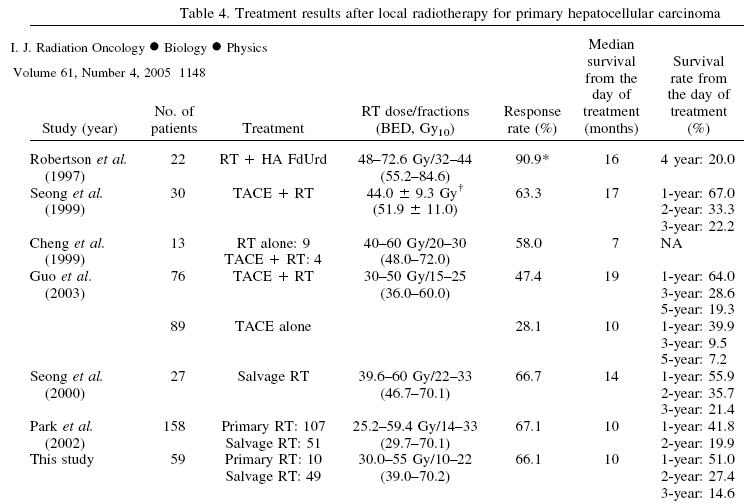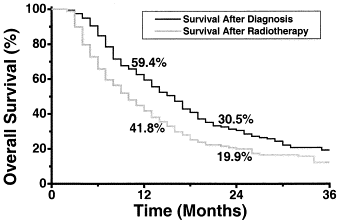|
Currently, a
dose-response relationship has not been established, using a large number of
patients, in local RT for HCC. However, indirect evidence suggests that the
higher the radiation dose, the better the response. Phillips and Murikami
showed that radiation doses <20 Gy were ineffective. Robertson
et al. suggested that a dose-response
relationship might exist for HCC, because hepatic control within the target
volume was particularly encouraging in the high-dose focal radiation group.
In contrast, their experience with whole liver RT determined that a
substantial proportion of patients progressed within the field of radiation.
The Radiation Therapy Oncology Group reported that 21 Gy whole liver RT plus
an additional two courses of 131I-antiferritin infusion, which is
comparable to 10–12 Gy, gave a better response (48%) than whole liver RT
alone (23%). This implies that increasing the radiation dose is important
for HCC; however, there is a paucity of appropriate published data for
establishing a dose-response relationship in localized RT.
In the current study, a
dose-response relationship was found with a total of 158 HCC patients
treated with localized RT. The average radiation dose was 50.1 ± 6.6 Gy in
the responders and 44.3 ± 9.0 Gy in the nonresponders. When the patients
were divided into three groups according to radiation dose, the tumor
response increased as the radiation dose increased. However, the average
tumor size was smallest, and the rate of PVT was lowest, in the group of
patients that received more than 50 Gy of radiation. It is thought that in
prescribing the radiation dose, physicians might have been influenced partly
by the larger tumor sizes of the patients with PVT and might have had a
tendency to escalate the radiation dose for patients who had better tumor
characteristics. Ohto et al. reported a
close relation between the rate of tumor response and the size of the tumor
. A PR was observed in 90% of patients with tumors smaller than 5 cm, but in
only 60% of those with tumors greater than 5 cm. Nevertheless, in this study
the rate of tumor response was influenced by neither tumor size nor the
presence of a PVT. Therefore, an increased RT dose was concluded to be
responsible for the improvement of the tumor response in the higher
radiation dose group, although there was an imbalance in the tumor size and
in the PVT proportion between each dose group.
Recently, a Michigan
group published an article addressing a dose-response relationship for
unresectable intrahepatic cancers. The group reported that higher radiation
doses were associated with improved survival for patients treated with
escalated focal liver radiation and concurrent hepatic artery
fluorodeoxyuridine, hypothesizing that the radiation dose would be a key
determinant of tumor control. In our study, we provide evidence that
escalating the radiation dose is the only significant factor for predicting
an objective tumor response. We are now testing whether the improved tumor
response by dose escalation could be correlated with improved survival.
Further analysis of a possible influence of radiation dose on survival is
ongoing.
The escalation of
radiation dose is frequently accompanied by increased toxicity. In this
study also, the rate of toxicity increased as radiation dose increased.
Liver cirrhosis adds an extra disadvantage in the application of RT to HCC.
In this study, 89.9% of patients had an associated LC. To prevent
radiation-related complications, appropriate determination of the radiation
field and radiation dose should be made; 3D-CRT seems to be helpful in this
regard.
One of the shortcomings
of this study was the failure to exclude the effects of concurrent
treatments from the radiation effect. To be sure, most patients in our study
were treated with another modality. The schedules of concurrent treatment
were heterogeneous due to the retrospective nature of the study. The
concurrent treatments consisted of systemic chemotherapy, transcatheter
arterial chemo-infusion, and transcatheter arterial chemo-embolization.
However, there was no difference between responders and nonresponders in the
proportion of patients who received concurrent treatment.
In conclusion, the
present study demonstrated a dose-response relationship in localized RT for
primary HCC. The tumor response improved, but complications arising from
increased RT doses were also observed. Dose escalation seems to be a very
important issue, and 3D-CRT may play a key role in local RT for HCC. |
|

Local radiotherapy for patients with unresectable
hepatocellular carcinoma,
2 February 2005
Park W,
International Journal of Radiation
Oncology*Biology*Physics
15 March 2005 (Vol. 61, Issue 4, Pages 1143-1150)
Between 1998
and 2002, 59 patients who were treated with localized RT were evaluated.
RT was delivered with a curative intent, and the radiation dose was 30–55
Gy (biologic effective dose of 39.0–70.2 Gy10
using the α/β ratio of 10 Gy) with 2–3 Gy as a daily dose. The tumor
response was evaluated by the change in maximum tumor size on serial CT
scans, and the morbidity was evaluated by the Common Terminology Criteria
for Adverse Events v3.0.
Results:
An objective tumor response
was achieved in 39 of 59 patients (66.1%) with complete response
(CR) in 5 patients and partial response (PR) in 34 patients. More than 50
Gy10 had a significant response; CR or PR
was 72.8% with >50 Gy10 and 46.7% with
≤50 Gy10 (p = 0.0299).
The 2-year overall survival rate
after RT was 27.4% (median survival time: 10 months), and this was
affected by the tumor response (p = 0.0640); the 2-year overall survival
rate after RT was 50.0% for CR and 21.8% for PR. There was no Grade 3 or 4
acute toxicity, and 3 patients (5.1%) developed gastric or duodenal ulcer.
Conclusions :Radiotherapy for unresectable HCC resulted in 66.1% of
tumor response with acceptable toxicity, and the radiation dose seems to
be a significant prognostic factor in RT response for HCC.
|

